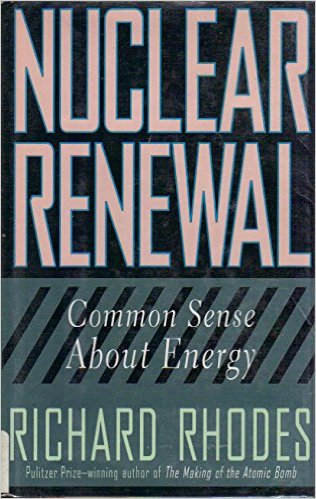

| NUCLEAR RENEWAL Common Sense About Energy Richard Rhodes New York: Whittle Books, September 1993 |
Rating: 4.5 High |
|||
| ISBN-13 978-0-670-85207-9 | ||||
| ISBN 0-670-85207-4 | 127pp. | HC | $17.50 | |
This book is little and short. Little in its physical dimensions, short in number of words and number of pages. But it is long on applicability and sensibility. In it, Rhodes discusses the reasons why nuclear reactors are to energy production what social security is to politics in the U.S. — the proverbial "third rail". Touch it and your career perishes. He notes that it is far different in France, which derives 80% of its electricity from fission, and in Japan, which is at 27% and rising.
Rhodes lays the moribund condition of nuclear power in America at the feet of utilities management. He acknowledges the contributions of other factors (anti-nuke activists, equipment makers, plant designers and builders, and regulators), but agrees with Forbes Magazine1 that utility-company executives have to shoulder the major portion of the blame.
Noting that antinuclear activists tend to be better educated than the average American, Rhodes asks why they choose to protest nuclear power [page 7]:
But of all possible industrial systems these ecological moralists might have attacked, why did they choose one so relatively benign as nuclear power? No one has been killed in a U.S. commercial nuclear power accident in three decades of successful operation, nor has commercial power released more than minimal amounts of radioactivity. Why not target the chemical industry, with its vast inventory of toxic wastes? Why not automobiles, with their ubiquitous and unhealthy smog and their 50,000 deaths a year? For that matter, why not coal power, which produces evident damage from acid rain and kills about 30,000 people per year with air pollution? |
But then Rhodes answers his rhetorical question — and the answer is one not on his list of factors above. It is the decades-long irresponsible use of radioactive elements, from the inception of the twentieth century, when those elements were discovered, through the decade after World War II. Radioisotopes were added to consumer products as varied as wristwatch dials and toothpaste; x-rays were routinely used to check the fit of shoes, as well as for disease diagnosis and treatment; and the militaries of several countries cavalierly scattered fallout abroad. The injuries that resulted surely helped give commercial nuclear power a bad name.
In my opinion it is slightly disingenuous to present this facet of the situation after the others he cites in his list. It gives the impression that public fear of radioactivity, growing out of long experience with radiation-caused injuries, is less significant than the high cost of nuclear plants.
Rhodes mentions other factors in the decline
After discussing the history of America's nuclear power industry, Rhodes gives us an inside look at the way fission is used to generate power in Japan and France. The key differences are: Greater standardization of reactor design; Imposition of more uniform operating rules, with corresponding oversight; in France, reliance on breeder reactors and fuel recycling. He also examines the two worst commercial reactor accidents to date: Three Mile Island in 1979 and Chernobyl in 1986. He compares the levels of individual risk those accidents present to other hazards. The comparison is eye-opening. Finally he shows us a glimpse of the Integral Fast Reactor (IFR), a new design that promises to be safe even in the event of a coolant failure.
As Rhodes admits, he wrote this book on an accelerated schedule. Several shortcomings flow from that fact. He comes across as too sanguine about reactor safety and rad-waste disposal. In his description of the IFR, he claims that its inherent safety comes from the fact that the fuel expands when heated, thus losing some of its reactivity because "Expansion moves the atoms of uranium and plutonium in the fuel slug farther apart." That statement is certainly true, but the book's intended audience would not likely be convinced, especially since he earlier notes that thermal expansion of fuel elements has caused problems in some reactors. He should have fleshed out the very brief explanation of this IFR feature. He doesn't give a full citation for the Forbes article he mentions on page 2. Also, there is no index and no chapter notes — a serious lack, in my opinion. (There is a reading list with six entries.) Even with these defects, and given its age, Nuclear Renewal is a worthwhile summary of the history and prospects of commercial nuclear power.

 To contact Chris Winter, send email to this address.
To contact Chris Winter, send email to this address.